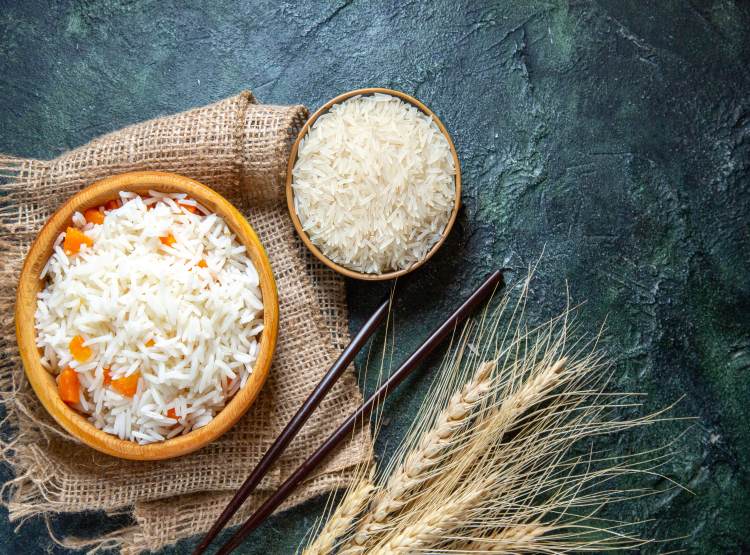Rice is a staple food in many countries. Countless varieties of rice are available for different culinary needs. Among them, basmati rice and non-basmati rice are two major categories that often spark curiosity among food enthusiasts.
Both these varieties are used in various cuisines. While many people believe that Basmati rice has long grains and non-Basmati rice has short grains, the two actually differ a lot in terms of aroma, texture, nutrition, and how they cook.
Whether you’re preparing an aromatic biryani or a simple everyday meal, choosing the right type of rice can enhance the overall taste and experience of your dish. In this blog, we’ll explore the key differences between basmati and non-basmati rice, helping you make an informed choice for your kitchen.
What is Basmati Rice?
Basmati rice is a premium variety of long-grain rice that is known for its unique aroma and delicate texture. The word “Basmati” comes from two Sanskrit words: “vaas” (meaning fragrance) and “matup” (meaning possessing). In northern India, the pronunciation of “va” changes to “ba,” so “Vaasmati” became “Basmati.”
This rice is primarily grown in the fertile plains of India and Pakistan, where the climate and soil conditions contribute to its distinct characteristics. Basmati rice stands out due to its long, slender grains that elongate when cooked. One of its most well-known qualities is its natural, aromatic fragrance, which is often compared to the scent of nuts or flowers.
What is Non-Basmati Rice?
Non-Basmati rice is the most commonly consumed rice variety globally, particularly in regions like East Asia, Southeast Asia, and parts of Africa. While Basmati rice is primarily grown in India and Pakistan, non-Basmati rice varieties are cultivated in various countries worldwide.
These rice types are more versatile and can be found in different grain lengths: short, medium, and long. Non-basmati rice is typically more affordable and available in a variety of forms, from white rice to brown rice. They offer a broad spectrum of textures, flavours, and uses in cooking.
Key Differences Between Basmati and Non-Basmati Rice
-
Grain Size and Shape
Basmati rice is known for its long, slender grains that are usually more than twice the length of the width. On the other hand, non-Basmati rice comes in a wide variety of grain types, ranging from short and round grains to medium and long grains.
-
Aroma and Flavour
Basmati rice is known for its nutty, floral aroma, which is released when cooked. Non-basmati rice has a milder aroma.
-
Texture and Cooking Properties
Basmati rice, when cooked properly, is light, fluffy, and separate. The long grains do not stick together. On the other hand, some varieties of non-basmati rice have a slightly sticky texture.
-
Water Absorption and Cooking Time
Basmati rice requires soaking for at least 30 minutes to an hour before cooking. It also typically takes longer to cook, usually around 15 to 20 minutes.
Non-Basmati rice tends to cook faster than Basmati rice. It generally does not require soaking and can be cooked directly after rinsing. The cooking time is typically shorter—around 10 to 15 minutes for most varieties.
-
Nutritional Value
Basmati rice is often considered a healthier option due to its lower glycemic index (GI) compared to many other rice varieties. The lower GI means that Basmati rice releases glucose into the bloodstream more slowly, which helps in managing blood sugar levels.
Non-Basmati rice varies in nutritional content depending on the variety. Generally, short-grain rice tends to be higher in starch, making it a more calorie-dense option. Brown varieties of non-Basmati rice, like brown Sona Masoori or Ponni, offer higher fibre and nutritional benefits.
-
Uses in Cooking
Basmati rice is preferred for making biryanis, pilafs, and pulao, where the rice needs to remain separate and absorb the rich flavours of the spices
Non-Basmati rice is typically used for everyday meals and more casual dishes. It is used for idlis, dosas, and pongal in South Indian cuisine, where it is combined with lentils and ground into batter. Non-Basmati rice is also used in soups, stews, risottos, and rice salads.
Which One Should You Choose?
The choice between Basmati and non-Basmati rice depends on your preference, cuisine, and nutritional needs. If you prefer long, fragrant, and fluffy rice, Basmati is ideal for dishes like biryani, pulao, and Persian rice. Its low glycemic index makes it a healthier option for people managing blood sugar levels.
On the other hand, non-Basmati rice offers varied textures and flavours, making it perfect for daily meals, South Indian dishes (idli, dosa), sticky rice dishes, and Asian cuisine.
Both Basmati and non-Basmati rice have unique characteristics that suit different culinary applications. Basmati stands out for its fragrance and fluffy texture, while non-Basmati is versatile and widely used in global cuisines. Your choice depends on taste, cooking style, and health goals.
Whatever your preference is, Trade Pros can fulfill it. We are one of the leading basmati and non-basmati rice suppliers in India. Connect with us and get high-quality rice of your choice!


